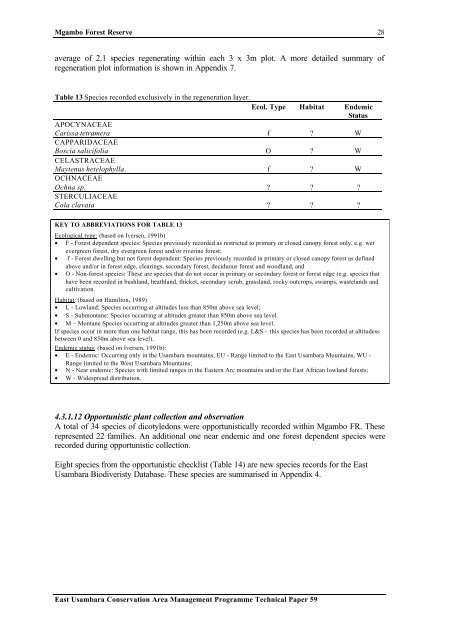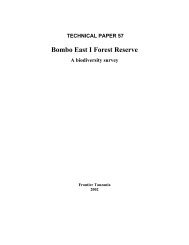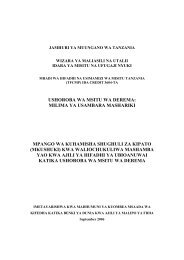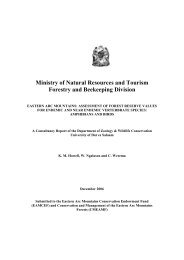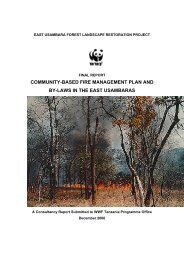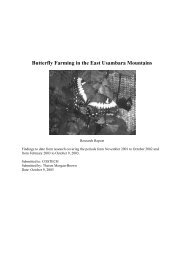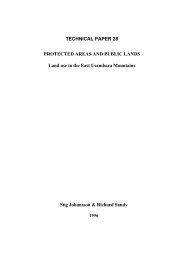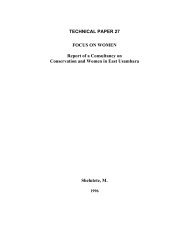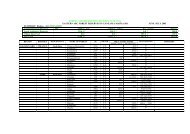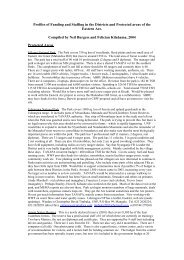Mgambo Forest Reserve: A biodiversity survey. - Eastern Arc ...
Mgambo Forest Reserve: A biodiversity survey. - Eastern Arc ...
Mgambo Forest Reserve: A biodiversity survey. - Eastern Arc ...
Create successful ePaper yourself
Turn your PDF publications into a flip-book with our unique Google optimized e-Paper software.
<strong>Mgambo</strong> <strong>Forest</strong> <strong>Reserve</strong><br />
average of 2.1 species regenerating within each 3 x 3m plot. A more detailed summary of<br />
regeneration plot information is shown in Appendix 7.<br />
Table 13 Species recorded exclusively in the regeneration layer.<br />
Ecol. Type Habitat Endemic<br />
Status<br />
APOCYNACEAE<br />
Carissa tetramera f ? W<br />
CAPPARIDACEAE<br />
Boscia salicifolia O ? W<br />
CELASTRACEAE<br />
Maytenus hetelophylla. f ? W<br />
OCHNACEAE<br />
Ochna sp. ? ? ?<br />
STERCULIACEAE<br />
Cola clavata ? ? ?<br />
KEY TO ABBREVIATIONS FOR TABLE 13<br />
Ecological type: (based on Iversen, 1991b)<br />
• F - <strong>Forest</strong> dependent species: Species previously recorded as restricted to primary or closed canopy forest only, e.g. wet<br />
evergreen forest, dry evergreen forest and/or riverine forest;<br />
• f - <strong>Forest</strong> dwelling but not forest dependent: Species previously recorded in primary or closed canopy forest as defined<br />
above and/or in forest edge, clearings, secondary forest, deciduous forest and woodland, and<br />
• O - Non-forest species: These are species that do not occur in primary or secondary forest or forest edge (e.g. species that<br />
have been recorded in bushland, heathland, thicket, secondary scrub, grassland, rocky outcrops, swamps, wastelands and<br />
cultivation.<br />
Habitat: (based on Hamilton, 1989)<br />
• L - Lowland: Species occurring at altitudes less than 850m above sea level;<br />
• S - Submontane: Species occurring at altitudes greater than 850m above sea level.<br />
• M – Montane Species occurring at altitudes greater than 1,250m above sea level.<br />
If species occur in more than one habitat range, this has been recorded (e.g. L&S – this species has been recorded at altitudess<br />
between 0 and 850m above sea level).<br />
Endemic status: (based on Iversen, 1991b):<br />
• E - Endemic: Occurring only in the Usambara mountains, EU - Range limited to the East Usambara Mountains, WU -<br />
Range limited to the West Usambara Mountains;<br />
• N - Near endemic: Species with limited ranges in the <strong>Eastern</strong> <strong>Arc</strong> mountains and/or the East African lowland forests;<br />
• W - Widespread distribution.<br />
4.3.1.12 Opportunistic plant collection and observation<br />
A total of 34 species of dicotyledons were opportunistically recorded within <strong>Mgambo</strong> FR. These<br />
represented 22 families. An additional one near endemic and one forest dependent species were<br />
recorded during opportunistic collection.<br />
Eight species from the opportunistic checklist (Table 14) are new species records for the East<br />
Usambara Biodiveristy Database. These species are summarised in Appendix 4.<br />
East Usambara Conservation Area Management Programme Technical Paper 59<br />
28


